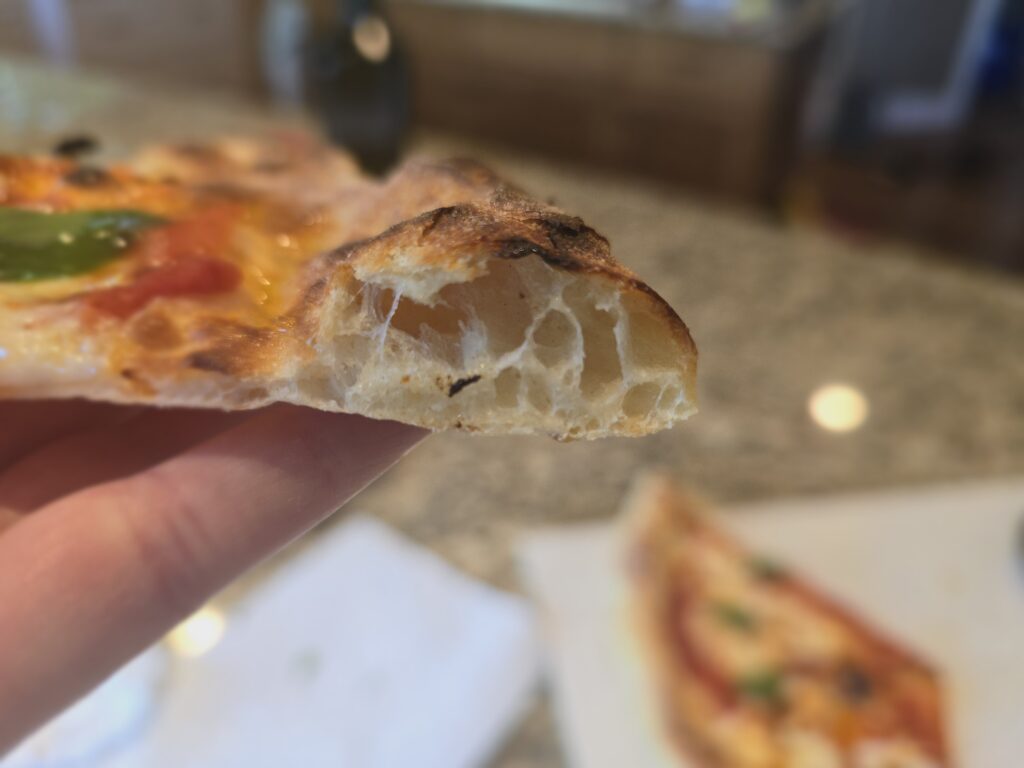Pizza Margherita, a beloved Italian classic, is all about achieving the perfect balance of a light and airy crust, vibrant tomato sauce, fresh mozzarella, and aromatic basil. But what if I told you that the secret to mastering this dish isn’t just in the toppings but in the flour itself?
While experimenting with different types of flours for my pizza dough, I realized the role that Manitoba flour can play in creating the ideal pizza base. Manitoba flour, also known as “Farina Manitoba,” is a high-gluten flour made from hard wheat originating from the Canadian province of Manitoba. Its exceptional strength and high protein content (14-15%) make it a popular choice among Italian pizza chefs for creating doughs that are both elastic and chewy with a great rise.
Why Manitoba Flour?
Manitoba flour is prized for its elasticity, water absorption, and strength. This type of flour has a W index that often exceeds 350, indicating its capacity to hold up against long fermentation and resist deformation during kneading and shaping. Its high protein content helps form strong gluten networks, resulting in a dough that can withstand prolonged leavening times, which is perfect for pizza recipes that demand a chewy, airy texture.
In fact, Manitoba flour’s unique properties make it a versatile ingredient that Italian bakers use not only for pizza but also for traditional recipes like panettone, pandoro, and croissants. It’s particularly favored in Italy, where it’s often combined with other flours to achieve the desired dough consistency for different types of bread and pastries.
The Science Behind Pizza Dough Preparation
When it comes to pizza dough, hydration, gluten development, and heat distribution are crucial factors. With Manitoba flour, the dough can absorb a higher amount of water (up to 70% of its weight) compared to other flours, resulting in a highly hydrated dough that creates a softer and more honeycombed crumb structure.
Key Techniques for Using Manitoba Flour:
- Hydration Levels: Because of its high gluten content, Manitoba flour can take on more water, which means you can push your hydration levels up to 65-70%. This increased hydration allows the dough to develop a wonderful chew and a slightly crisp exterior when baked at high temperatures.
- Kneading and Gluten Development: To maximize gluten formation, knead the dough until it is smooth and elastic. This is particularly important when using Manitoba flour, as it responds well to prolonged kneading. Allowing the dough to rest at intervals helps the gluten relax, making it easier to shape.
- Fermentation Time: Extended fermentation times are another benefit of using Manitoba flour. This flour can withstand long rising times without compromising its structure, allowing you to achieve a light and airy dough with complex flavors developed through slow fermentation.
Baking Techniques: Baking Steel, High Heat, and Broiling
For Pizza Margherita, I use a combination of baking and broiling to create the ideal crust and texture. Here’s why:
- Baking Steel or Stone: A baking steel or stone retains heat efficiently, creating a consistent, high-temperature surface that helps cook the bottom of the pizza evenly. This results in a crisp yet tender base.
- Broiling for Color and Texture: Broiling at the end helps caramelize the crust and cheese, adding a beautiful golden hue and enhancing the flavor. The rapid exposure to high heat also prevents overcooking of the delicate toppings.
- Heat Distribution: Manitoba flour’s tolerance to mechanical stress and its ability to maintain structure make it suitable for high-temperature baking (500°F or more). The high gluten content and elasticity ensure that the dough retains its shape and develops the right texture without collapsing.
Why Manitoba Flour Isn’t Always the Best Choice
While Manitoba flour is fantastic for creating a strong dough with great elasticity, it may not be suitable for all recipes due to its high gluten content. For softer, less chewy baked goods, consider using a blend of Manitoba and a lower-protein flour, like Tipo 00, to balance strength with extensibility.
My Pizza Margherita Recipe: A Nod to Tradition and Innovation
The pizza I’m sharing here uses a combination of long-fermentation Manitoba flour dough and the dual cooking method of baking and broiling. With a base that’s crisp yet airy, the flavors of fresh tomatoes, mozzarella, and basil come together harmoniously.
What sets my Pizza Margherita apart is not only the high-quality Manitoba flour but also the methodical attention to dough preparation and baking. Each bite has a perfect balance of chewiness, crunch, and lightness—proof that even the simplest of pizzas can be elevated with the right ingredients and techniques.
I’d love for you to try this recipe and experience the difference that Manitoba flour can make in your own kitchen.

Pizza Margherita aka Typical Neapolitan Pizza / Pizza Napolitana
Ingredients
4 cups bread flour
2.5 tsp kosher salt
1 package of instant yeast
1 2/3 cup water, room temperature
- For the Topping:
28 oz whole San Marzano type tomatoes
1 lb fresh Mozzarella cheese, cubed into 1/2 inch chunks
fresh basil leaves
kosher salt
olive oil
Directions
- Mix flour, salt and instant yeast with a wooden spoon in a large bowl. Pour water and keep mixing with a wooden spoon and your hands until all the flour is moistened and no dry flour remains. Cover the bowl well with plastic wrap and leave on the counter for 8 hours. A bit more is ok, but don't go over 12 hours.
- Divide the dough into 4 portions and transfer into large resealable bags. Refrigerate for around 48 hours. I wouldn't go over 3 days in the fridge.
- When ready to make pizza, remove from the fridge 2-3 hours prior to baking. Punch the dough to deflate and remove air from it. Transfer each dough ball to an oiled medium sized bowl and cover well with plastic wrap. Allow to rise at room temperature for 2-3 hours.
- While the dough is doing its final rise, place tomatoes into a fine mesh sieve. Press them down gently with your hands or a spoon to remove moisture. Let it drain for about an hour in a sieve set over a bowl. Place Mozarella on top of paper towels, top with some more paper towels and press down with something hard (such as a skillet.) This should step should remove moisture from the tomatoes and the cheese, which will prevent your pizza from becoming too soggy.
- Place the oven racks into the second highest row. Place pizza steel, pizza stone or a the very least heavy baking sheet into the oven and preheat it to 550F for at least 45 minutes. I use pizza steel, baking sheet may not provide the sufficient heat for this style of pizza.
- To make sauce: blend drained tomatoes with 1/2 heaping tsp of kosher salt until smooth.
- When ready to cook, dust the surface with flour. I do this on top of parchment paper to prevent the pizza from sticking. Stretch the pizza out into 12 inch circle. Try your very best to never use a rolling pin. Stretch gently, until the pizza is no more than 3 mm thick (except the edges - allow those to be bit thicker.)
- Spread about 3 TBSP tomato sauce on top of your pizza. Season with some more kosher salt. It's very little sauce, but this pizza is all about the quality of the dough. Place 1/4 of your cheese chunks on top of the sauce. Drizzle lightly with some olive oil. Transfer the pizza to the oven, placing it on top of your preheated baking steel. Bake for 2.5 minutes, then switch the broiler to high and broil for an additional 2 minutes until the pizza is nicely charred in spots.
- Remove the pizza to a cutting board, top with some fresh basil. Cut into pieces and enjoy immediately. It should be soft, elastic, tender, fragrant and maintain its shape when you fold it while devouring it! Repeat with the remaining dough balls.












